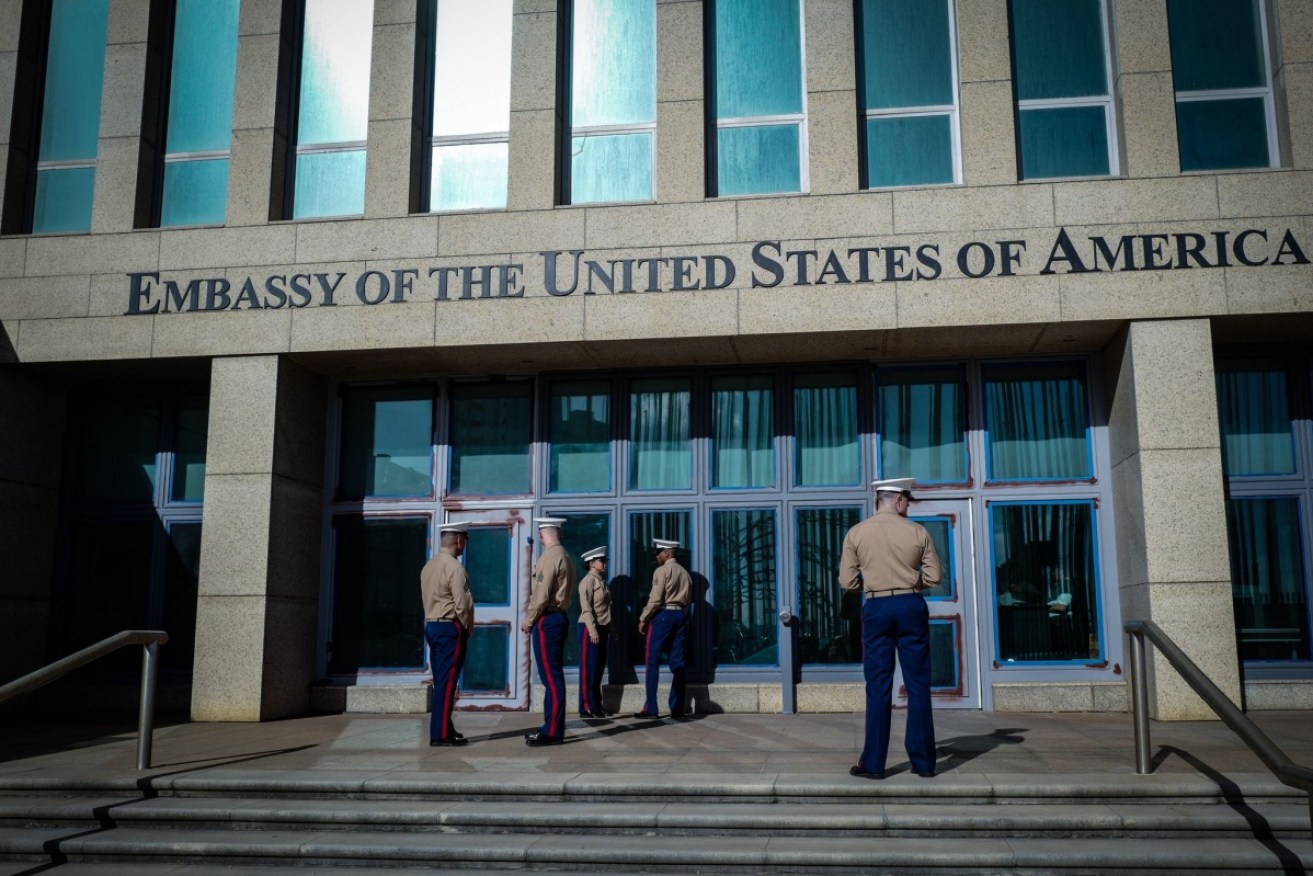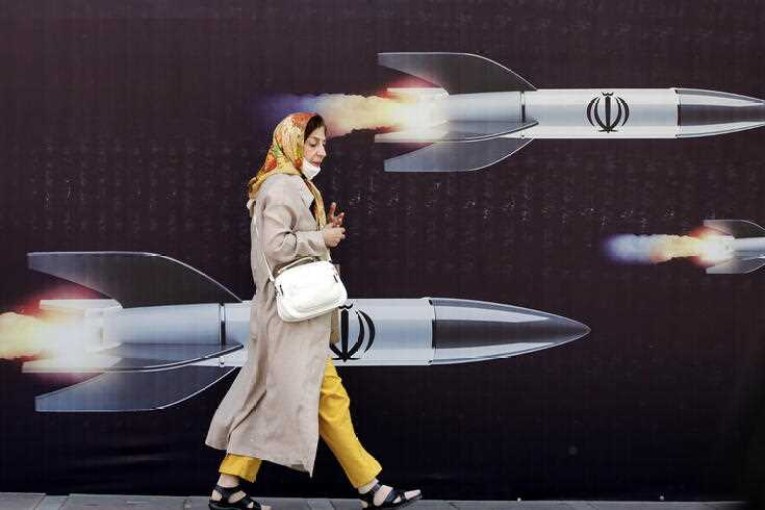Invisible weapon the prime suspect in ‘attack’ on US embassy

In February, diplomats at the US embassy in Havana reported strange noises and mysterious symptoms. Photo: Getty
During the Cold War, Washington feared that Moscow was seeking to turn microwave radiation into covert weapons of mind control.
More recently, the US military itself sought to develop microwave arms that could invisibly beam painfully loud booms and even spoken words into people’s heads. The aims were to disable attackers and wage psychological warfare.
Now, doctors and scientists say such unconventional weapons may have caused the baffling symptoms and ailments that, starting in late 2016, hit more than three dozen US diplomats and their family members in Cuba and China. The Cuban incidents resulted in a diplomatic rupture between Havana and Washington.
The medical team that examined 21 affected diplomats from Cuba made no mention of microwaves in its detailed report published in JAMA in March.
But Douglas H Smith, the study’s lead author and director of the Center for Brain Injury and Repair at the University of Pennsylvania, said in a recent interview that microwaves were now considered a main suspect and that the team was increasingly sure the diplomats had suffered brain injury.
“Everybody was relatively skeptical at first,” he said, “and everyone now agrees there’s something there.”
Dr Smith remarked that the diplomats and doctors jokingly refer to the trauma as the immaculate concussion.
Strikes with microwaves, some experts now argue, more plausibly explain reports of painful sounds, ills and traumas than do other possible culprits — sonic attacks, viral infections and contagious anxiety.
In particular, a growing number of analysts cite an eerie phenomenon known as the Frey effect, named after Allan Frey, an American scientist. Long ago, he found that microwaves can trick the brain into perceiving what seem to be ordinary sounds.
The false sensations, experts say, could account for a defining symptom of the diplomatic incidents: The perception of loud noises, including ringing, buzzing and grinding. Initially, experts cited those symptoms as evidence of stealthy attacks with sonic weapons.
 Members of JASON, a secretive group of elite scientists that helps the US federal government assess new threats to national security, say it has been scrutinising the diplomatic mystery and weighing possible explanations, including microwaves.
Members of JASON, a secretive group of elite scientists that helps the US federal government assess new threats to national security, say it has been scrutinising the diplomatic mystery and weighing possible explanations, including microwaves.
Asked about the microwave theory of the case, the State Department said the investigation had yet to identify the cause or source of the attacks. The FBI declined to comment on the status of the investigation or any theories.
The microwave idea teems with unanswered questions. Who fired the beams? The Russian government? The Cuban government? A rogue Cuban faction sympathetic to Moscow? And, if so, where did the attackers get the unconventional arms?
Developing a new class of weapons

Allan Frey, at his home outside Washington. In 1960, he stumbled on an acoustic effect of microwaves that was eventually named after him. Photo: NYT
Microwaves are ubiquitous in modern life. The short radio waves power radars, cook foods, relay messages and link mobile phones to antenna towers. They are a form of electromagnetic radiation on the same spectrum as light and X-rays, only at the opposite end.
While radio broadcasting can employ waves a mile or more in length, microwaves range in size from roughly a foot to a fraction of an inch. They are seen as harmless in such everyday uses as microwaving foods. But their diminutive size also enables tight focusing, as when dish antennas turn disorganised rays into concentrated beams.
The dimensions of the human head, scientists say, make it a fairly good antenna for picking up microwave signals. Dr Frey, a biologist, said he stumbled on the acoustic effect in 1960. The Soviets took notice — and furtively, globally, the threat grew.
Soviet research on microwaves for “internal sound perception,” the Defense Intelligence Agency warned in 1976, showed great promise for “disrupting the behaviour patterns of military or diplomatic personnel”.
The National Security Agency gave Mark Zaid, a Washington lawyer who routinely gets security clearances to discuss classified matters, a statement on how a foreign power built a weapon “designed to bathe a target’s living quarters in microwaves, causing numerous physical effects, including a damaged nervous system”.
Mr Zaid said a NSA client of his who travelled there watched in disbelief as his nervous system later unravelled, starting with control of his fingers.

The high-pitched chirping that diplomats heard while working at the Consulate General of the United States in Guangzhou, China, might be explained by a phenomenon known as the Frey effect — radio-frequency hearing. Photo: NYT
Washington, too, foresaw new kinds of arms: In Albuquerque, New Mexico, air force scientists sought to beam comprehensible speech into the heads of adversaries.
Russia, China and many European states are seen as having the know-how to make basic microwave weapons that can debilitate, sow noise or even kill. Advanced powers, experts say, might accomplish more nuanced aims, such as beaming spoken words into people’s heads. Only intelligence agencies know which nations actually possess and use such unfamiliar arms.
The basic weapon might look like a satellite dish. In theory, such a device might be hand-held or mounted in a van, car, boat or helicopter. Microwave arms are seen as typically working over relatively short distances — across the length of a few rooms or blocks. High-powered ones might be able to fire beams for several miles.
The hypothesis

Beatrice Golomb, a medical doctor and professor of medicine at the University of California, San Diego, argues microwave strikes can explain the diplomatic ills. Photo: NYT
Early this year, in January, the spooky impact of microwaves on the human brain never came up during an open Senate hearing on the Cuba crisis.
But in a scientific paper that same month, James C Lin of the University of Illinois, a leading investigator of the Frey effect, described the diplomatic ills as plausibly arising from microwave beams. Dr Lin is the editor-in-chief of Bio Electro Magnetics, a peer-reviewed journal that explores the effects of radio waves and electromagnetic fields on living things.
In his paper, he said high-intensity beams of microwaves could have caused the diplomats to experience not just loud noises but nausea, headaches and vertigo, as well as possible brain-tissue injury. The beams, he added, could be fired covertly, hitting “only the intended target”.
In February, ProPublica in a lengthy investigation mentioned that federal investigators were weighing the microwave theory. Separately, it told of an intriguing find. The wife of a member of the embassy staff, it reported, had looked outside her home after hearing the disturbing sounds and seen a van speeding away.
A dish antenna could fit easily into a small van.
The medical team that studied the Cuba diplomats ascribed the symptoms in the March JAMA study to “an unknown energy source” that was highly directional. Some personnel, it noted, had covered their ears and heads but experienced no sound reduction. The team said the diplomats appeared to have developed signs of concussion without having received any blows to the head.
In May, reports emerged that American diplomats in China had suffered similar traumas. Secretary of State Mike Pompeo called the medical details of the two groups “very similar” and “entirely consistent” with one another. By late June, the State Department had evacuated at least 11 Americans from China.
To date, the most detailed medical case for microwave strikes has been made by Beatrice Golomb, a medical doctor and professor of medicine at the University of California, San Diego. In a forthcoming paper to be published in October in Neural Computation, a peer-reviewed journal of the MIT Press, she lays out potential medical evidence for Cuban microwave strikes.
She compared the symptoms of the diplomats in Cuba to those reported for individuals said to be suffering from radio-frequency sickness. The health responses of the two groups, Dr Golomb wrote, “conform closely”.
In closing, she argued that “numerous highly specific features” of the diplomatic incidents “fit the hypothesis” of a microwave attack, including the Frey-type production of disturbing sounds.
Scientists still disagree over what hit the diplomats. Last month, JAMA ran four letters critical of the March study, some faulting the report for ruling out mass hysteria.
But Mr Zaid, the Washington lawyer, who represents eight of the diplomats and family members, said microwave attacks may have injured his clients.
“It’s sort of naïve to think this just started now,” he said. Globally, he added, covert strikes with the potent beams appear to have been going on for decades.
Francisco Palmieri, a State Department official, was asked during the open Senate hearing if “attacks against US personnel in Cuba” had been raised with Moscow.
“That is a very good question,” Mr Palmieri replied. But addressing it, he added, would require “a classified setting”.
For his part, Mr Frey says he doubts the case will be solved any time soon. The novelty of the crisis, its sporadic nature and the foreign setting made it hard for federal investigators to gather clues and draw conclusions, he said, much less file charges.
“Based on what I know,” he remarked, “it will remain a mystery.”
-The New York Times








